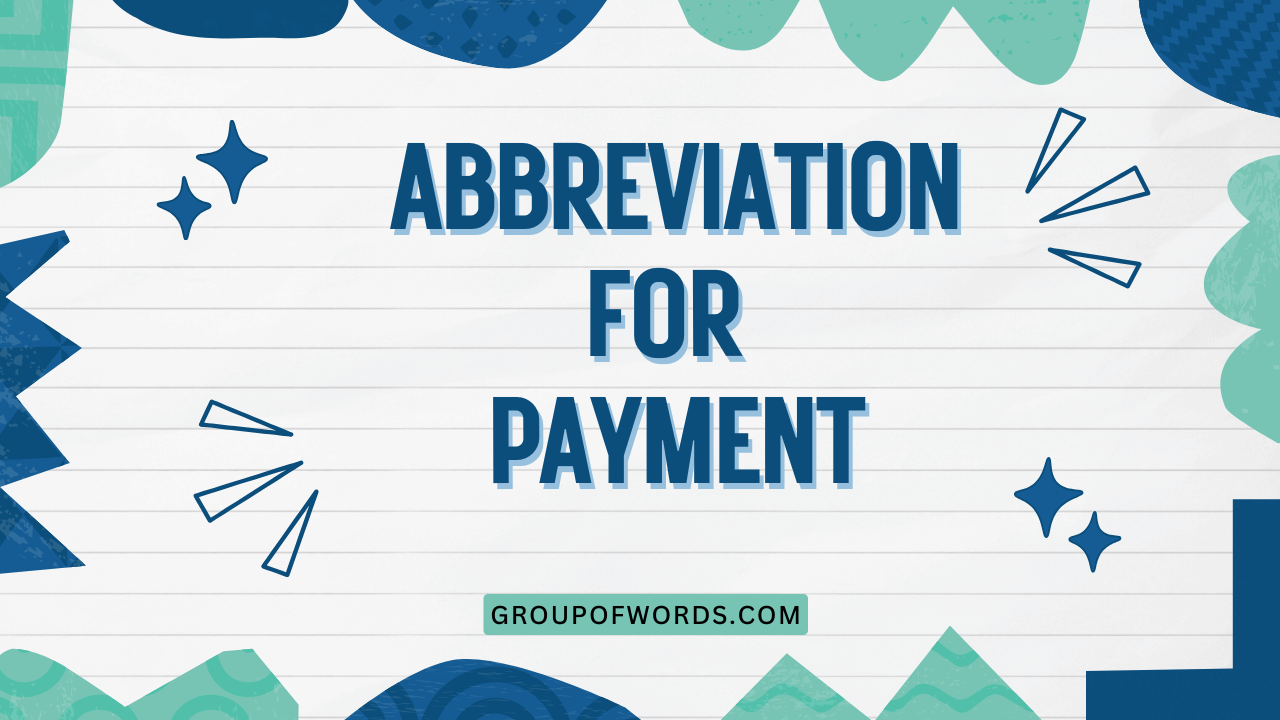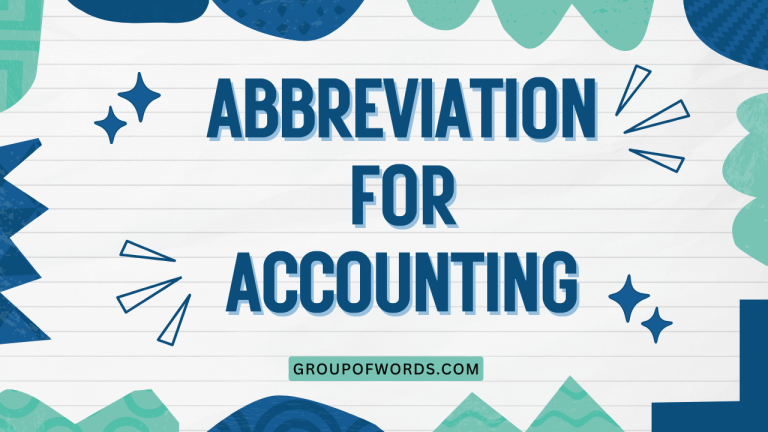Abbreviations for Payment: A Comprehensive Guide
Understanding abbreviations for payment is crucial in both professional and everyday financial transactions. These abbreviations, designed for brevity and clarity, are commonly used in invoices, receipts, and financial statements.
Mastery of these abbreviations ensures accurate record-keeping, efficient communication, and a clear understanding of financial documents. This guide provides a detailed overview of common payment abbreviations, their meanings, and their appropriate usage, benefiting students, business professionals, and anyone managing personal finances.
Table of Contents
- Introduction
- Definition of Payment Abbreviations
- Structural Breakdown of Payment Abbreviations
- Types and Categories of Payment Abbreviations
- Examples of Payment Abbreviations
- Usage Rules for Payment Abbreviations
- Common Mistakes in Using Payment Abbreviations
- Practice Exercises
- Advanced Topics in Payment Abbreviations
- Frequently Asked Questions (FAQ)
- Conclusion
Introduction
In the world of finance and commerce, efficiency and clarity are paramount. Abbreviations for payment serve as a shorthand, allowing for concise communication and documentation.
Whether you are managing a business, tracking personal expenses, or simply reviewing a bill, understanding these abbreviations is essential. This guide provides a comprehensive exploration of payment abbreviations, their meanings, and their proper application, equipping you with the knowledge to navigate financial documents with confidence.
From common payment methods to transaction statuses, we will cover it all.
This article is designed for a broad audience, including students learning about business practices, professionals in finance and accounting, and individuals seeking to improve their financial literacy. By mastering the abbreviations discussed here, you can enhance your understanding of financial transactions, improve your communication with vendors and clients, and ensure accurate record-keeping.
Let’s delve into the world of payment abbreviations and unlock their practical applications.
Definition of Payment Abbreviations
Payment abbreviations are shortened forms of words or phrases related to financial transactions. They are used to represent payment methods, dates, statuses, currencies, and other relevant information in a concise and easily understandable manner.
These abbreviations are widely used in invoices, receipts, bank statements, and other financial documents to save space and improve readability.
The primary function of payment abbreviations is to streamline communication and documentation in financial contexts. By using abbreviations, businesses and individuals can quickly convey important information about payments without having to write out lengthy descriptions.
This not only saves time but also reduces the risk of errors and misunderstandings. Understanding these abbreviations is crucial for accurate record-keeping and effective financial management.
Payment abbreviations can be classified based on their function: method abbreviations (e.g., CC for credit card), date abbreviations (e.g., EOM for end of month), status abbreviations (e.g., PD for paid), currency abbreviations (e.g., USD for United States Dollar), and transaction abbreviations (e.g., P.O. for purchase order). Each category serves a specific purpose in conveying information about a payment. The context in which an abbreviation is used often provides clues to its meaning, but familiarity with common abbreviations is essential for accurate interpretation.
Structural Breakdown of Payment Abbreviations
Payment abbreviations are typically formed by taking the first letter or letters of the words in a phrase. For example, “Cash on Delivery” is often abbreviated as COD.
Some abbreviations use a combination of letters and numbers, while others may include punctuation marks. Understanding the structure of these abbreviations can help in deciphering their meaning, even when encountering unfamiliar ones.
Many abbreviations follow a simple pattern of using the initial letters of each word in the phrase. For instance, “Electronic Funds Transfer” becomes EFT.
However, some abbreviations may omit certain letters or use alternative forms to avoid confusion with other abbreviations. For example, “Due on Receipt” might be abbreviated as DOR or DR.
It’s important to note that some abbreviations are specific to certain industries or regions, so familiarity with local conventions is helpful.
The use of acronyms is also common in payment abbreviations. An acronym is formed by combining the first letters of a series of words to create a new word, such as “ASAP” for “As Soon As Possible,” often used regarding payment deadlines.
In some cases, abbreviations may include numbers to indicate specific dates or quantities, such as “Net 30,” which means payment is due within 30 days.
Types and Categories of Payment Abbreviations
Payment abbreviations can be categorized based on their function and the type of information they convey. This section will explore different categories of payment abbreviations, including payment method abbreviations, date-related abbreviations, payment status abbreviations, currency abbreviations, and transaction-related abbreviations.
Payment Method Abbreviations
Payment method abbreviations indicate how a payment was made. These abbreviations are commonly used in invoices, receipts, and accounting records to track the method of payment.
Some common examples include:
- CC: Credit Card
- DC: Debit Card
- CK: Check
- CA: Cash
- EFT: Electronic Funds Transfer
- MO: Money Order
- PP: PayPal
- WIRE: Wire Transfer
Date-Related Abbreviations
Date-related abbreviations specify payment terms or deadlines. These abbreviations are frequently used in invoices and contracts to indicate when payment is due.
Common examples include:
- EOM: End of Month
- NET 30: Payment due within 30 days
- NET 60: Payment due within 60 days
- DOR: Due on Receipt
- COD: Cash on Delivery
- DOP: Date of Payment
Payment Status Abbreviations
Payment status abbreviations indicate the current state of a payment. These abbreviations are used to track whether a payment has been made, is pending, or is overdue.
Examples include:
- PD: Paid
- PA: Partially Paid
- OD: Overdue
- PEN: Pending
- REF: Refunded
- CAN: Cancelled
Currency Abbreviations
Currency abbreviations represent different currencies used in transactions. These abbreviations are standardized and recognized globally.
Some examples include:
- USD: United States Dollar
- EUR: Euro
- GBP: British Pound
- JPY: Japanese Yen
- CAD: Canadian Dollar
- AUD: Australian Dollar
Transaction-Related Abbreviations
Transaction-related abbreviations refer to specific details of a transaction, such as the purchase order number or invoice number. These abbreviations help to identify and track individual transactions.
Examples include:
- P.O.: Purchase Order
- INV: Invoice
- REC: Receipt
- REF: Reference
- TXN: Transaction
Examples of Payment Abbreviations
To further illustrate the use of payment abbreviations, let’s examine various examples in different contexts. The following tables provide a comprehensive overview of common payment abbreviations and their meanings.
The following table provides examples of payment method abbreviations used in various financial documents. Understanding these abbreviations is essential for accurately recording and interpreting payment information.
| Abbreviation | Meaning | Example Sentence |
|---|---|---|
| CC | Credit Card | Payment was made via CC. |
| DC | Debit Card | The customer paid using their DC. |
| CK | Check | We received a CK for the invoice amount. |
| CA | Cash | The transaction was completed with CA. |
| EFT | Electronic Funds Transfer | The funds were transferred via EFT. |
| MO | Money Order | A MO was sent to cover the payment. |
| PP | PayPal | The payment was processed through PP. |
| WIRE | Wire Transfer | We sent the payment via WIRE. |
| ACH | Automated Clearing House | The payment was made through ACH. |
| BT | Bank Transfer | The invoice was settled with a BT. |
| DD | Direct Debit | The bill was paid by DD. |
| GC | Gift Card | The customer used a GC for the purchase. |
| VC | Voucher Code | A VC was applied to the order. |
| SC | Store Credit | The purchase was made using SC. |
| BTC | Bitcoin | The payment was processed with BTC. |
| ETH | Ethereum | We accept payments via ETH. |
| CR | Cryptocurrency | Payment was made with CR. |
| Mobile Pay | Mobile Payment | The transaction occurred via Mobile Pay. |
| AliPay | Alipay Payment | The customer used AliPay to settle the transaction. |
| WEPAY | WePay Payment | The payment was processed through WEPAY. |
| SQ | Square Payment | The client used SQ to pay their invoice. |
| AP | Apple Pay | Payment was completed via AP. |
| GP | Google Pay | The purchase was made through GP. |
| Samsung Pay | Samsung Pay Payment | The transaction was processed with Samsung Pay. |
| MC | MasterCard | Payment was done via MC. |
| VISA | VISA Payment | The customer used VISA to settle the transaction. |
| Discover | Discover Payment | The payment was processed through Discover. |
The following table provides examples of date-related abbreviations commonly used in invoices and payment terms. Understanding these abbreviations helps in managing payment schedules and deadlines.
| Abbreviation | Meaning | Example Sentence |
|---|---|---|
| EOM | End of Month | Payment is due EOM. |
| NET 30 | Payment due within 30 days | The invoice is payable NET 30. |
| NET 60 | Payment due within 60 days | Payment terms are NET 60. |
| DOR | Due on Receipt | Payment is DOR. |
| COD | Cash on Delivery | The goods will be delivered COD. |
| DOP | Date of Payment | Please indicate the DOP on the form. |
| 2/10 NET 30 | 2% discount if paid within 10 days, otherwise due in 30 days | The invoice offers a 2/10 NET 30 discount. |
| CIA | Cash in Advance | Payment is required CIA. |
| DUE | Payment Due Date | The DUE is listed on the invoice. |
| PPD | Prepaid | The order was PPD. |
| NOW | Immediate Payment | This service requires NOW. |
| YTD | Year to Date | The payment for services this YTD is considerable. |
| QTD | Quarter to Date | The payment for services this QTD is considerable. |
| MTD | Month to Date | The payment for services this MTD is considerable. |
| ASAP | As Soon As Possible | We need this payment ASAP. |
| BIW | Before Invoice Week | Payment should be processed BIW. |
| BIM | Before Invoice Month | Payment should be processed BIM. |
| BOY | Begining of Year | We need payment by the BOY. |
| EOQ | End of Quarter | We need payment by the EOQ. |
| EOY | End of Year | We need payment by the EOY. |
| BIQ | Before Invoice Quarter | Payment should be processed BIQ. |
| 1/10 Net 30 | 1% discount if paid within 10 days, otherwise due in 30 days | The invoice offers a 1/10 NET 30 discount. |
| 2/15 Net 45 | 2% discount if paid within 15 days, otherwise due in 45 days | The invoice offers a 2/15 NET 45 discount. |
| 5/10 Net 60 | 5% discount if paid within 10 days, otherwise due in 60 days | The invoice offers a 5/10 NET 60 discount. |
The following table illustrates payment status abbreviations. These abbreviations are essential for tracking the progress of payments and managing accounts receivable.
| Abbreviation | Meaning | Example Sentence |
|---|---|---|
| PD | Paid | The invoice has been PD. |
| PA | Partially Paid | The invoice is PA. |
| OD | Overdue | The payment is OD. |
| PEN | Pending | The transaction is currently PEN. |
| REF | Refunded | The customer was REF. |
| CAN | Cancelled | The order was CAN. |
| UNP | Unpaid | The invoice remains UNP. |
| REC | Received | The payment was REC. |
| Pro | Processed | The payment was Pro. |
| APP | Approved | The payment was APP. |
| REJ | Rejected | The payment was REJ. |
| FUL | Fulfilled | The payment was FUL. |
| COM | Completed | The payment was COM. |
| Auth | Authorized | The payment was Auth. |
| Settled | Settled | The payment was Settled. |
| Bounced | Bounced | The payment was Bounced. |
| Voided | Voided | The payment was Voided. |
| Failed | Failed | The payment has Failed. |
| In Progress | In Progress | The payment is In Progress. |
| On Hold | On Hold | The payment is On Hold. |
| Reversed | Reversed | The payment was Reversed. |
| Disputed | Disputed | The payment is Disputed. |
| Escrow | Escrow | The payment is in Escrow. |
| Partial | Partial | The payment is Partial. |
The following table illustrates the currency abbreviations. These abbreviations are essential for international transactions and financial reporting.
| Abbreviation | Meaning | Example Sentence |
|---|---|---|
| USD | United States Dollar | The price is listed in USD. |
| EUR | Euro | Payment can be made in EUR. |
| GBP | British Pound | The cost is GBP 100. |
| JPY | Japanese Yen | The transaction was completed in JPY. |
| CAD | Canadian Dollar | The invoice is in CAD. |
| AUD | Australian Dollar | The amount is AUD 50. |
| CHF | Swiss Franc | The price is listed in CHF. |
| CNY | Chinese Yuan | Payment can be made in CNY. |
| INR | Indian Rupee | The cost is INR 100. |
| BRL | Brazilian Real | The transaction was completed in BRL. |
| RUB | Russian Ruble | The invoice is in RUB. |
| KRW | South Korean Won | The amount is KRW 50. |
| MXN | Mexican Peso | The price is listed in MXN. |
| SGD | Singapore Dollar | Payment can be made in SGD. |
| HKD | Hong Kong Dollar | The cost is HKD 100. |
| NOK | Norwegian Krone | The transaction was completed in NOK. |
| SEK | Swedish Krona | The invoice is in SEK. |
| NZD | New Zealand Dollar | The amount is NZD 50. |
| ZAR | South African Rand | The cost is ZAR 100. |
| TRY | Turkish Lira | The transaction was completed in TRY. |
| DKK | Danish Krone | The invoice is in DKK. |
| PLN | Polish Zloty | The amount is PLN 50. |
| THB | Thai Baht | The price is listed in THB. |
| HUF | Hungarian Forint | Payment can be made in HUF. |
The following table illustrates transaction-related abbreviations. These abbreviations are essential for properly documenting financial records.
| Abbreviation | Meaning | Example Sentence |
|---|---|---|
| P.O. | Purchase Order | Refer to P.O. #12345. |
| INV | Invoice | See INV #67890 for details. |
| REC | Receipt | Keep the REC for your records. |
| REF | Reference | Use REF code ABC123. |
| TXN | Transaction | The TXN was successful. |
| ACCT | Account | The payment was made to the correct ACCT. |
| BAL | Balance | The outstanding BAL is $500. |
| CR | Credit | A CR of $100 was applied. |
| DR | Debit | A DR of $100 was applied. |
| VAT | Value Added Tax | The price is inclusive of VAT. |
| GST | Goods and Services Tax | The invoice includes GST. |
| TAX | Tax | The TAX amount is clearly stated. |
| DISC | Discount | A DISC was applied. |
| S&H | Shipping and Handling | The charges include S&H. |
| PMT | Payment | Confirm the PMT details. |
| AUTH Code | Authorization Code | The AUTH Code is required. |
| Batch No | Batch Number | The Batch No is used for tracking. |
| Invoice No | Invoice Number | The Invoice No needs to be correct for billing. |
| Tracking No | Tracking Number | The Tracking No can be used to see the package location. |
| Claim No | Claim Number | The Claim No is used for insurance purposes. |
| Acct No | Account Number | The Acct No needs to be correct for billing. |
| Ref No | Reference Number | The Ref No is used for documentation. |
| Trans ID | Transaction ID | The Trans ID is used for tracking. |
| CRN | Credit Reference Number | The CRN is used for documentation. |
Usage Rules for Payment Abbreviations
Using payment abbreviations correctly is crucial for clear and accurate communication. There are several rules to consider when using these abbreviations.
First, ensure that the abbreviations are widely recognized and understood in your specific context. When in doubt, spell out the full term to avoid confusion.
Second, be consistent in your usage of abbreviations throughout a document or communication. Mixing different abbreviations for the same term can lead to misunderstandings.
Finally, always consider your audience and their level of familiarity with payment abbreviations. If you are communicating with someone who may not be familiar with these abbreviations, it is best to spell out the terms.
Another important rule is to use the correct capitalization for abbreviations. Some abbreviations are always written in uppercase (e.g., USD), while others are written in lowercase (e.g., ca).
Pay attention to the standard convention for each abbreviation to ensure accuracy. Additionally, be mindful of punctuation.
Some abbreviations include periods (e.g., P.O.), while others do not (e.g., EFT). Adhering to these conventions will enhance the clarity and professionalism of your communication.
When using date-related abbreviations, be especially careful to avoid ambiguity. For example, “EOM” can be interpreted differently depending on the context.
To avoid confusion, specify the exact date whenever possible. Similarly, when using abbreviations for payment terms, clearly state the number of days allowed for payment (e.g., “NET 30” means payment is due within 30 days).
Clarity and precision are essential when dealing with financial matters.
Common Mistakes in Using Payment Abbreviations
Despite their convenience, payment abbreviations are often misused, leading to confusion and errors. One common mistake is using unfamiliar or non-standard abbreviations.
Always stick to widely recognized abbreviations to ensure that your message is clearly understood. Another mistake is using abbreviations inconsistently within the same document or communication.
Choose one abbreviation for a term and use it consistently throughout.
Another frequent error is misunderstanding the meaning of an abbreviation. For example, confusing “DOR” (Due on Receipt) with “DOP” (Date of Payment) can lead to payment delays and misunderstandings.
Always double-check the meaning of an abbreviation before using it. Additionally, be cautious when using abbreviations that have multiple meanings.
The context should make it clear which meaning is intended, but if there is any ambiguity, it is best to spell out the term.
Failing to consider the audience is another common mistake. If you are communicating with someone who may not be familiar with payment abbreviations, it is best to avoid them altogether or to provide a glossary of terms.
Remember that clarity and accuracy are paramount in financial communication, so err on the side of caution when using abbreviations.
Here are some examples of common mistakes:
| Incorrect | Correct | Explanation |
|---|---|---|
| Pay via CrCard | Pay via CC | Use the standard abbreviation for Credit Card. |
| Due EOMonth | Due EOM | Use the standard abbreviation for End of Month. |
| Invoic Paid | Invoice PD | Use the standard abbreviation for Paid. |
| Amount in US$ | Amount in USD | Use the standard abbreviation for United States Dollar. |
| Ref. Number | REF | Use the standard abbreviation for Reference. |
Practice Exercises
To reinforce your understanding of payment abbreviations, complete the following exercises. These exercises will test your knowledge of common abbreviations and their meanings.
Each exercise consists of multiple-choice questions and fill-in-the-blank questions.
Exercise 1: Multiple Choice
Choose the correct meaning of the following abbreviations:
- What does “CC” stand for?
- Cash Check
- Credit Card
- Company Check
- Certified Check
- What does “EOM” stand for?
- End of Month
- End of Money
- Early of Month
- Easy of Month
- What does “PD” stand for?
- Pending
- Partially Done
- Paid
- Payment Due
- What does “USD” stand for?
- United States Department
- United States Dollar
- United States Dominion
- United Social Department
- What does “P.O.” stand for?
- Payment Order
- Purchase Output
- Purchase Order
- Payment Output
- What does “INV” stand for?
- Invest
- Invoice
- Involve
- Investigation
- What does “REC” stand for?
- Record
- Receive
- Receipt
- Reconcile
- What does “EFT” stand for?
- Excellent Funds Transfer
- Electronic Funds Transfer
- Easy Funds Transfer
- Effective Funds Transfer
- What does “MO” stand for?
- Many Orders
- Money Output
- Money Order
- More Orders
- What does “REF” stand for?
- Reference
- Refund
- Refine
- Refute
Exercise 2: Fill in the Blanks
Fill in the blanks with the correct payment abbreviation:
- Payment is due at the ________ (End of Month).
- The invoice was paid via ________ (Credit Card).
- The transaction is currently ________ (Pending).
- The amount is in ________ (United States Dollar).
- Please refer to ________ (Purchase Order) #12345.
- The invoice has been ________ (Paid).
- The customer used ________ (Debit Card) to pay.
- We received a ________ (Money Order) for the payment.
- The funds were transferred via ________ (Electronic Funds Transfer).
- See ________ (Invoice) #67890 for details.
Answers to Exercises
Exercise 1: Multiple Choice Answers
- b
- a
- c
- b
- c
- b
- c
- b
- c
- a
Exercise 2: Fill in the Blanks Answers
- EOM
- CC
- PEN
- USD
- P.O.
- PD
- DC
- MO
- EFT
- INV
Advanced Topics in Payment Abbreviations
For advanced learners, it’s important to delve deeper into the nuances of payment abbreviations. This includes understanding industry-specific abbreviations, regional variations, and the evolving landscape of digital payment abbreviations.
Certain industries, such as healthcare and government, may use unique abbreviations related to billing and reimbursement. Familiarity with these abbreviations is essential for professionals in those fields.
Regional variations in payment abbreviations also exist. For example, some abbreviations may be more common in certain countries or regions than others.
Understanding these regional differences can help avoid confusion when dealing with international transactions. Additionally, the rise of digital payments has led to the emergence of new abbreviations related to cryptocurrency, mobile payments, and online platforms.
Staying up-to-date with these
new abbreviations is crucial for professionals in the financial sector.
The ongoing evolution of payment technology also introduces new abbreviations. For instance, with the rise of blockchain and decentralized finance (DeFi), new abbreviations are constantly emerging to represent various digital assets and transaction types.
Keeping abreast of these changes requires continuous learning and adaptation. Subscriptions to industry newsletters, participation in professional forums, and ongoing education can help you stay informed about the latest developments in payment abbreviations.
Frequently Asked Questions (FAQ)
What is the most common payment abbreviation?
The most common payment abbreviations include CC (Credit Card), DC (Debit Card), and EFT (Electronic Funds Transfer). These abbreviations are widely used in various financial documents and transactions.
How can I ensure that I am using payment abbreviations correctly?
To ensure correct usage, always refer to standard abbreviation guides, consider your audience, and be consistent in your usage. When in doubt, spell out the full term to avoid confusion.
Are payment abbreviations universal?
While many payment abbreviations are widely recognized, some may be specific to certain regions or industries. Always consider the context and audience when using payment abbreviations.
Where can I find a comprehensive list of payment abbreviations?
Comprehensive lists of payment abbreviations can be found in financial dictionaries, online resources, and industry-specific guides. This article also provides a detailed overview of common payment abbreviations.
How do I handle conflicting abbreviations?
If an abbreviation has multiple meanings, provide context to clarify the intended meaning. If ambiguity persists, spell out the full term to avoid confusion.
What should I do if I encounter an unfamiliar payment abbreviation?
If you encounter an unfamiliar payment abbreviation, consult a financial dictionary or online resource. You can also ask for clarification from the sender of the document or communication.
Are there legal standards for payment abbreviations?
While there are no specific legal standards for payment abbreviations, it’s important to use them accurately and consistently to avoid legal or financial disputes. Misrepresenting payment information can have legal consequences.
How are payment abbreviations changing with new payment technologies?
New payment technologies, such as cryptocurrency and mobile payments, are introducing new abbreviations. Stay informed about these changes by subscribing to industry newsletters, participating in professional forums, and pursuing ongoing education.
Conclusion
Mastering payment abbreviations is essential for effective communication and accurate record-keeping in the world of finance and commerce. By understanding the definitions, structural breakdown, and usage rules of these abbreviations, you can enhance your financial literacy and improve your professional skills.
This guide has provided a comprehensive overview of common payment abbreviations, examples of their usage, and tips for avoiding common mistakes.
As the financial landscape continues to evolve, it is crucial to stay updated with the latest developments in payment abbreviations. Continuous learning and adaptation will enable you to navigate financial documents with confidence and ensure that you are always communicating clearly and accurately.
Whether you are a student, a business professional, or an individual managing personal finances, the knowledge of payment abbreviations is a valuable asset.
In conclusion, embrace the power of payment abbreviations to streamline your financial transactions, improve your communication, and enhance your overall financial management skills. By mastering these abbreviations, you can unlock a world of efficiency and clarity in the realm of finance.






